Bellatrix Aerospace: Reimagining space mobility and satellites-as-a-service
Having persevered for a decade, Rohan Ganapathy and Yashas Karanam are on the cusp of breaking out Bellatrix Aerospace as an important spacetech venture from India
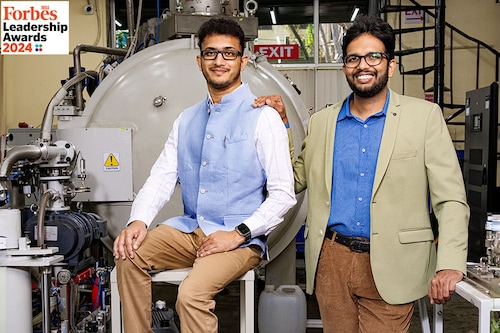

More than 10 years ago, a letter from the late Abdul Kalam touched off an entrepreneurial journey for Rohan Ganapathy and Yashas Karanam that became Bellatrix Aerospace, which last year launched its first tech demonstrator in-space propulsion system.
Bellatrix wasn’t named for the evil character in the Harry Potter series. “We named it after the star in the constellation Orion. That’s where we want to head, maybe say 500 years from now," Ganapathy says.
In 2012, still in college, his initial goal was to do something that would get him a seat in one of the Ivy League universities. He’d been inspired by a visit to the Goddard Space Flight Center in the US and a chance to meet Neil Armstrong and Buzz Aldrin.
Back home, he teamed up with two juniors at college to build an engine that would run on water as a propellant. They didn’t have the money, and weren’t able to raise any. When a well-wisher brought word to Kalam about Ganapathy and his interest in spacetech, the former president asked to meet him.
Kalam couldn’t help with money, but he wrote them a recommendation letter, in 2013, which opened doors. JSW Steel offered a grant of ₹20 lakh, which allowed them to rent a garage and work on their project after college into the wee hours of the morning.
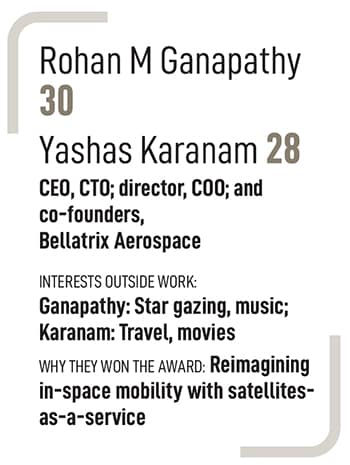 Karanam was Ganapathy’s friend, their families knew each other, and his interest in entrepreneurship was complementary. In 2015, Ganapathy’s project to build a prototype engine that used water as a propellant worked, and it was the year they incorporated Bellatrix officially as a private limited company.
Karanam was Ganapathy’s friend, their families knew each other, and his interest in entrepreneurship was complementary. In 2015, Ganapathy’s project to build a prototype engine that used water as a propellant worked, and it was the year they incorporated Bellatrix officially as a private limited company.
“We have four classes of engines which can cater to satellites ranging from 10 kg all the way up to 5,000 kg," Ganapathy says. These thrusters are based on the ‘Hall effect’, named after the 19th-century physicist Edwin H Hall, whose work on the effect of magnetic fields on electrons, eventually led to this technology.
While national space agencies such as Nasa and Isro are more interested in such thrusters for large satellites and deep-space applications, Ganapathy and Karaman decided they can also build smaller engines that can be fitted to smaller satellites operating closer to Earth.
They have developed Hall effect thrusters specifically for small satellites, which weigh in the 100 kg to 200 kg range. And a second category, called microwave plasma thrusters, which use water as a propellant, is on offer for satellites which weigh above 1000 kg.
Bellatrix is also working on a non-toxic green rocket propellant, which is in the qualification stage.
Hall thrusters are well known, initially developed by the Russians in the early 70s. Many advances have happened since then, and “what we have done is we have miniaturised it so that it can fit into even a 50 kg satellite," Ganapathy says.
Building them, however, involves sourcing components like valves, tanks, electronics, other subsystems, and auxiliary systems which needed to be imported, and added wait times of 12-14 months. Therefore, the entrepreneurs decided to completely vertically integrate. Today, Bellatrix has one of Asia’s biggest space simulation facilities as well, set up within the campus of the Indian Institute of Science in Bengaluru.
“Now our indigenisation content is around 84 percent. And what sets us apart is, from the date of order, we can deliver a space qualified propulsion system in less than four months," Ganapathy says.
Karanam adds that external factors are also contributing to the growth of the private space industry in India today. Important milestones include the announcement of India’s New Space Policy in April 2023, which also deemed IN-SPACe as a regulatory agency.
And, over the years, India becoming party to most of the important multilateral treaties that govern the sale and export of dual-use technologies, is also a significant factor.
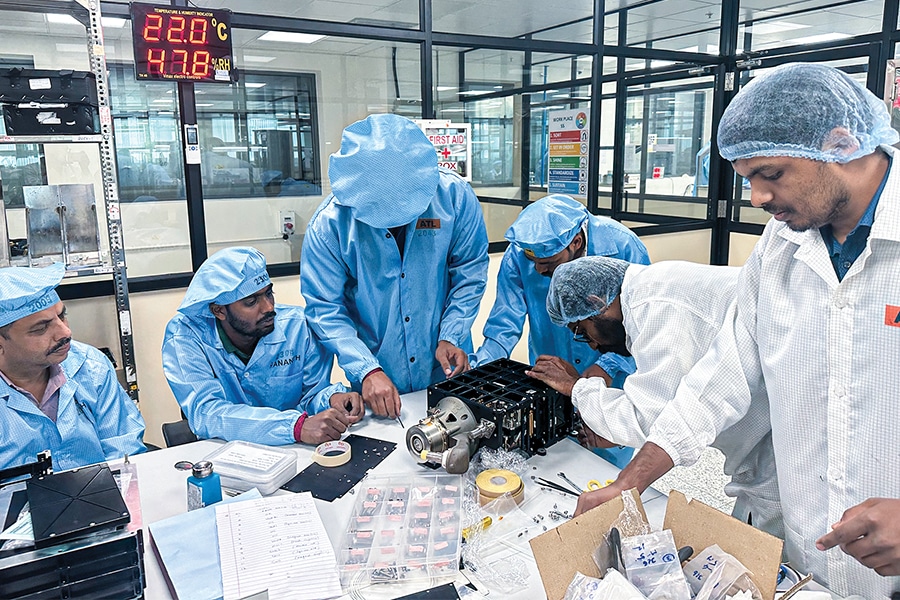 A team of engineers assembles an electric engine for satellites at the Bellatrix Aerospace lab in Bengaluru
A team of engineers assembles an electric engine for satellites at the Bellatrix Aerospace lab in Bengaluru
The global space industry is undergoing an important shift, from the traditional government-led programmes to a mix of actors, led more by private companies, a report on the sector by Arthur D Little, a multinational management consultancy, noted in July 2023.
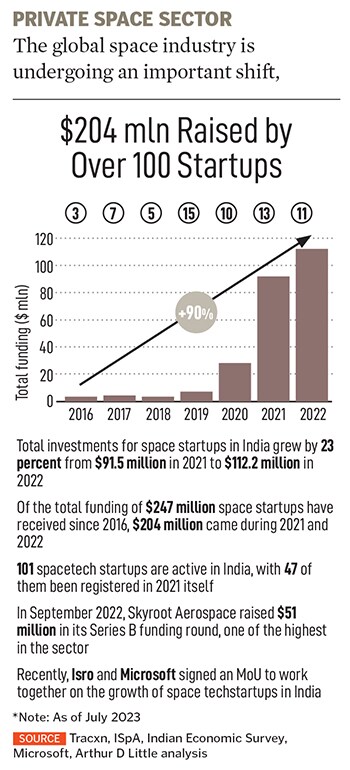 The nascent spacetech startup ecosystem in India, helped by the liberalised space economy rules and supported by Isro, is an example of this shift. And, with the right initiatives, India could tap this shift to go from a $8 billion space economy to $100 billion by 2040, according to the consultancy.
The nascent spacetech startup ecosystem in India, helped by the liberalised space economy rules and supported by Isro, is an example of this shift. And, with the right initiatives, India could tap this shift to go from a $8 billion space economy to $100 billion by 2040, according to the consultancy.
Over the last two decades, India has launched 381 satellites for 34 countries, making it a preferred destination for satellite launches worldwide, ADL notes.
On the startup front, Indian space tech entrepreneurs are building private space launch vehicles, satellites carrying hyperspectral imaging cameras and satellite-based data services for a range of sectors from agriculture to mining. The government has invested $112 million in funding for new-age space startups in the country, according to ADL.
The Indian space market, valued at $8 billion, has a CAGR of 4 percent, outpacing the global average of 2 percent, according to ADL. The government’s estimate is that India’s space economy could reach $40 billion by 2040.
In June, India also joined the Artemis Accords, a multilateral space initiative led by the US, with the initial objective of sending humans back to the Moon.
“In the long term, sooner rather than later, India would have had to kind of hedge its bets, ensuring that we too would benefit from whatever comes out of deep space exploration," Narayan Prasad, co-founder and COO of Satsearch, a space industry marketplace provider, and co-founder of Spaceport SARABHAI, an Indian space economy think tank, told Forbes India earlier. “There is always going to be a strategic angle to all of this because in the end, we should never get away from not being self-reliant."
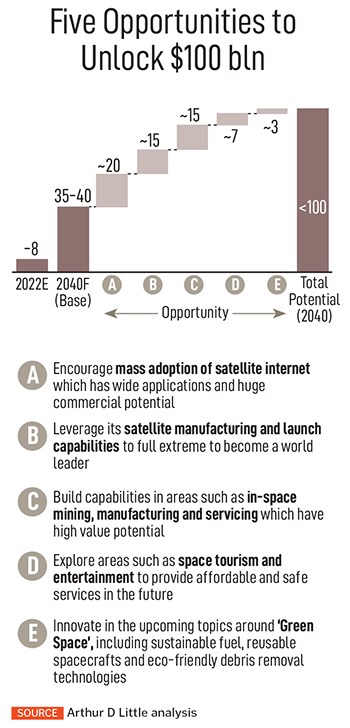 Even countries like Australia that were dependent on the US for a long time have started creating their space programmes, allocating their own budgets, and India, which has already done that, has a lead, he points out. “Now it’s just a question of how much further we want to go. It comes down to how much Indian policymakers are willing to invest in space to either do it independently or to do it with other countries."
Even countries like Australia that were dependent on the US for a long time have started creating their space programmes, allocating their own budgets, and India, which has already done that, has a lead, he points out. “Now it’s just a question of how much further we want to go. It comes down to how much Indian policymakers are willing to invest in space to either do it independently or to do it with other countries."
China, for example, has 500 active satellites today, compared to India’s 50. The Chinese have about 40 to 50 space launches a year, whereas India does it four to five times. And that comes down to the Chinese GDP having grown about six times to that of India, he says.
India is currently “stuck" at around ₹10,000-12,000 crore a year in space exploration expenses, he says. However, with the economic growth, if the space investments’ share as a proportion of the GDP remains or is even raised a bit, then as India doubles its economy if the space industry investments also double to around ₹25,000 crore, then many more space missions could be funded, he says.
At Bellatrix, the entrepreneurs were “one of the first movers from India to knock on doors and get people to look at funding the space sector and policy change", Karanam says, “and get them to believe that there are private companies capable of building their own product lines, which have global interest."
“From a business perspective we are trying to compete and position ourselves in a global market in such a way that we are ahead of the curve even when you compare us with some of the leaders in the segment in US and Europe," he says.
“It’s not just technology, but also the supply chain and the cost aspects. How Elon Musk looked at the rocket industry, I think we are doing something like that for in-space mobility."
To that effect, Bellatrix wants to go beyond making thrusters, to offer what they call “space taxis" to satellite OEMs and operators. “We have transitioned to a space mobility company," Karanam says. They’re developing strong capabilities to “build the satellites and take say 10 customers on board, like an Uber pool".
“So we take 10 customers on a single rocket, but 10 customers each have 10 locations to board or 10 orbits. We’ll be able to separately inject them at their orbits. So that’s how we have evolved."
They have signed some early contracts to sell thrusters and feedback has been good both in India and overseas, Karanam says. Today, Bellatrix is a team of about 100 engineers.
There’s one other innovation with their space taxi idea. “The same space taxi can also function as a dedicated satellite," Ganapathy points out. This would allow customers to focus on their core payload—like an imaging system or a communications system—and not worry about building a satellite around that payload.
Once the space taxi deploys various payloads to their intended orbits, it can still function as a satellite to host another payload and post-deployment, the ownership can be transferred to the customer. In other words, satellites as a service.
Bellatrix last raised about $8 million in Series A funding, in 2022, from investors, including BASF Venture Capital, Inflexor and Pavestone Capital, taking its total to about $11.3 million.
The founders are now actively in talks for more investments, as they plan to build a futuristic factory, on the outskirts of Bengaluru. By 2026, they expect their R&D to hit steady state, and commercial activity to take off.
First Published: Mar 21, 2024, 17:56
Subscribe Now